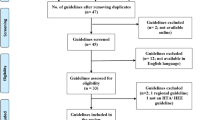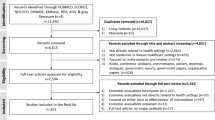Abstract
A review was performed of the key methodological elements of all the published economic evaluations (EEs), available in the European Network of Health Economics Evaluation Database (EURONHEED), of healthcare technologies conducted in Europe over the past 10 years in order to identify and compare the methodological patterns of EEs conducted in different countries.
Selected for analysis were summaries of EEs of interventions for bacterial and viral infections, and diseases of the digestive and respiratory tracts. The summaries were obtained from the EURONHEED. There were 346 studies that fulfilled the selection criteria. The statistical analyses consisted of a descriptive analysis and a bivariate inference analysis to assess associations between the different variables, essentially between the variables of country, year of publication and methodology applied.
Of the summaries examined, approximately 50% focused on pharmacological interventions. The most frequent type of analysis was that of cost effectiveness. The technologies most evaluated referred to treatments (versus diagnosis or prevention technologies). The perspective was mostly that of the health service. The sensitivity analysis most applied was univariate and the model type mostly used was the decision-tree. Over the period assessed, there were significant differences between countries in the types of EE, the perspective from which the studies were performed and in the practice of discounting costs and health effects.
Although there has been an improvement in methodologies since the year 2000, there are studies that still fail to take into account key elements of EE necessary for a study to be considered of high quality. For better appreciation of the potential capacity for the transfer of results of EEs between jurisdictions, the methodologies used in health EE studies in the different European countries need to be known in greater detail.






Similar content being viewed by others
Notes
For instance, the variability in the treatment of certain methodology elements, as highlighted by Barbieri et al.,6 influences the variability of the results. This would have an impact on the generalizability and, hence, affect the direct use of the findings of the EE study in decision making.
Note that not all of these studies were CUA because some studies calculated QALYs but not the cost-utility ratio.
References
Drummond M, Brandt A, Luce B, et al. Standardizing methodologies for economic evaluation in health care: practice, problems and potential. Int J Technol Assess Health Care 1993; 9: 26–36
EUROMET. The influence of economic evaluation studies on health care decision-making: an European survey. In: Eberhardt S, Stoklossa C, von der Schulenburg JMG, editors. Biomedical and Health Research. Amsterdam: IOS Press, 2004
Pouvourville G, Ulmann P, Nixon J, et al. The diffusion of health economics knowledge in Europe: the EURONHEED (European Network of Health Economics Evaluation Database) Project. Pharmacoeconomics 2005; 23 (2): 113–20
Nixon J, Rice S, Drummond M, et al. Guidelines for completing the EURONHEED transferability information checklists. Eur J Health Econ 2009; 10 (2): 157–65. Epub 2008 Jul 11
Boulenger S, Nixon J, Drummond M, et al. Can economic evaluations be made more transferable? Eur J Health Econ 2005; 6: 334–46
Barbieri M, Drummond M, Willke R, et al. Variability of cost-effectiveness estimates for pharmaceuticals in Western Europe: lessons for inferring generalizability. Value Health 2005; 8 (1): 10–23
Nixon J, Stoykova B, Glanville J, et al. The U.K. NHS economic evaluation database. Int J Technol Assess Health Care 2000; 16 (3): 731–42
Garattinni L, De Compadri P, Clemente R, et al. Economic evaluations in Italy: a review of the literature. Int J Technol Assess Health Care 2003; 19 (4): 685–737
García Altés A. Twenty years of health care economic analysis in Spain: are we doing well? Health Econ 2001; 10: 715–29
Oliva J, Del Llano J, Sacristán J. Análisis de las evaluaciones económicas de tecnologías sanitarias realizadas en España en la década 1990–2000. Gaceta Sanitaria 2002; 16 (2): 2–11
Drummond MF, O’Brien BJ, Stoddart GL, et al. Methods for the economic evaluation of health care programs. 2nd ed. New York: Oxford University Press, 1997
Acknowledgements
This work was supported by the Spanish Fund of Health Research (project number PI060282). Editorial assistance was from Dr Peter R. Turner of t-SciMed (Reus, Spain).
Author information
Authors and Affiliations
Corresponding author
Rights and permissions
About this article
Cite this article
Hutter, F., Antoñanzas, F. Economic Evaluations in the EURONHEED. Pharmacoeconomics 27, 561–570 (2009). https://doi.org/10.2165/11310060-000000000-00000
Published:
Issue Date:
DOI: https://doi.org/10.2165/11310060-000000000-00000




